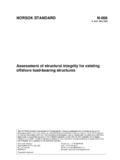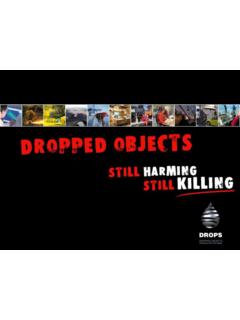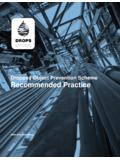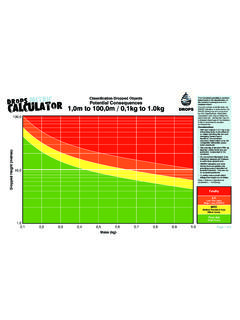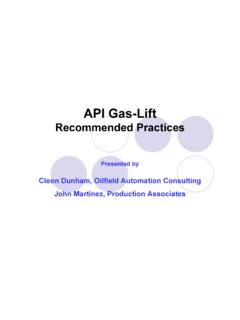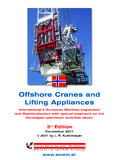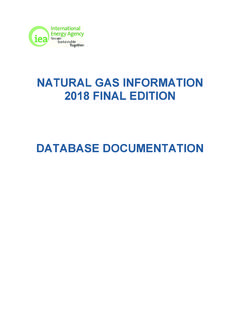Transcription of Good practice guideline Working at height in the …
1 good practice guidelineWorking at height in the offshore wind industryIn partnership withGOOD practice GUIDELINEWORKING AT height IN THE offshore WIND INDUSTRY1st editionNovember 2014 Published by ENERGY INSTITUTE, LONDONThe Energy Institute is a professional membership body incorporated by Royal Charter 2003 Registered charity number 1097899 The Energy Institute (EI) is the chartered professional membership body for the energy industry , supporting over 19 000 individuals Working in or studying energy and 250 energy companies worldwide.
2 The EI provides learning and networking opportunities to support professional development, as well as professional recognition and technical and scientific knowledge resources on energy in all its forms and EI s purpose is to develop and disseminate knowledge, skills and good practice towards a safe, secure and sustainable energy system. In fulfilling this mission, the EI addresses the depth and breadth of the energy sector, from fuels and fuels distribution to health and safety, sustainability and the environment. It also informs policy by providing a platform for debate and scientifically-sound information on energy issues.
3 The EI is licensed by: the Engineering Council to award Chartered, Incorporated and Engineering Technician status; the Science Council to award Chartered Scientist status, and the Society for the Environment to award Chartered Environmentalist also offers its own Chartered Energy Engineer, Chartered Petroleum Engineer and Chartered Energy Manager registered charity, the EI serves society with independence, professionalism and a wealth of expertise in all energy publication has been produced as a result of work carried out within the Technical Team of the EI, funded by the EI s Technical Partners.
4 The EI s Technical Work Programme provides industry with cost-effective, value-adding knowledge on key current and future issues affecting those operating in the energy sector, both in the UK and further information, please visit EI gratefully acknowledges the financial contributions towards the development of this publication from members of the G9 offshore Wind Health and Safety EnergyE. ONRWES cottish PowerSSES tatkraftStatoilVattenfall Copyright 2014 by the Energy Institute, Energy Institute is a professional membership body incorporated by Royal Charter charity number 1097899, EnglandAll rights reservedNo part of this book may be reproduced by any means.
5 Or transmitted or translated into a machine language without the written permission of the 978 0 85293 720 4 Published by the Energy InstituteThe information contained in this publication is provided for general information purposes only. Whilst the Energy Institute and the contributors have applied reasonable care in developing this publication, no representations or warranties, express or implied, are made by the Energy Institute or any of the contributors concerning the applicability, suitability, accuracy or completeness of the information contained herein and the Energy Institute and the contributors accept no responsibility whatsoever for the use of this information.
6 Neither the Energy Institute nor any of the contributors shall be liable in any way for any liability, loss, cost or damage incurred as a result of the receipt or use of the information contained copy and electronic access to EI and IP publications is available via our website, can be purchased online as downloadable pdfs or on an annual subscription for single users and more information, contact the EI Publications : cover image courtesy of practice guideline Working AT height IN THE offshore WIND ..81 Introduction.
7 9 Interface with other G9 Standards ..102 Hierarchy of protective measures for work at Lifecycle phase Common requirements for access Access from vessel to external platform ..18 Access to Access to WTG tower ..24 Nacelle interior ..26 Nacelle Nacelle Blade Meteorological Work on Contractor Temporary Provision of equipment for safe work at height ..31 Commissioning and operations and maintenance (O&M).
8 32 Contractor/vessel selection/mobilisation requirements ..32 Planning work ..32 Maintenance of equipment for work at Topic guidance ..36 Introduction ..36 Common requirements ..36 Training ..37 Fitness ..38 Use of Competence for specific Work at height on PPE ..42 Falling objects ..43 Falling object risk management ..43 Supervisory/ Working PPE and falling Hazards during specific practice guideline Working AT height IN THE offshore WIND INDUSTRY4 Contents Page Transfer between vessels and offshore Task-specific PPE requirements.
9 50 Fitness Protection against falling: SRL on boat landing Supervisory/ Working Training and Hazards during specific Access to Working Hazards during specific Use of rope access ..72 Rescue from Working locations to vessel or helihoist platform ..74 Preparation for Supervisory/ Working Hazards during specific Safe behaviour for work at Introduction: importance and approach ..81 Contributory Specific behaviours for safe work at height .
10 825 Flowcharts: preparation/review of operational Preparatory Writing the Implementation of the procedure ..91 Review of procedures ..92 AnnexesAnnex A EU Directive and national regulations ..93 The Relevant content of the Review of selected national work at height Great Britain and Northern The Netherlands ..100 B Review of existing work at height C Guidance on technical and equipment standards.
